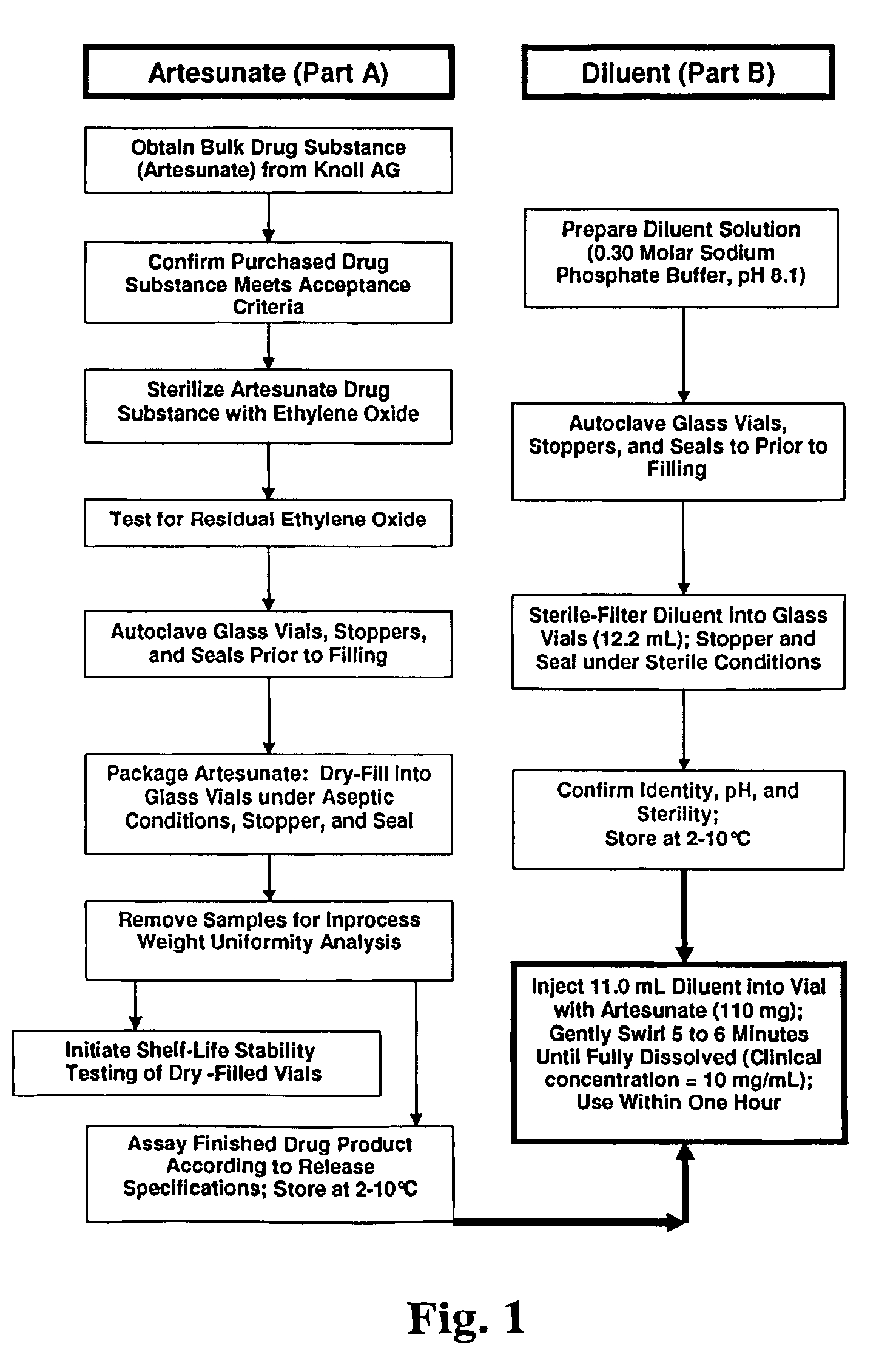Methods for the formulation and manufacture of artesunic acid for injection
a technology of artesunic acid and formulation, which is applied in the direction of biocide, antiparasitic agents, drug compositions, etc., can solve the problems of limited practical dosage formulation choices, low return on investment, and little interest in the development of new or manufacturing established antimalarial drugs. , to achieve the effect of improving the drug produ
- Summary
- Abstract
- Description
- Claims
- Application Information
AI Technical Summary
Benefits of technology
Problems solved by technology
Method used
Image
Examples
example 1
GMP Formulation and Packaging
[0068]Upon receipt of the accessible portions of the European Drug Master File (DMF) for artesunic acid from Knoll, the inventors compared their analytical protocols for artesunic acid to those used in the DMF. The DMF method used by Knoll is as follows:
[0069]Validation of an HPLC-Based Assay for AS
[0070]HPLC was performed using the following conditions:
[0071]
LC systemSolvent DeliveryWaters 600 Pump System ControllerInjectorWaters 717+ Auto SamplerDetectorWaters 996 Photo Diode Array (PDA)QuantitationEmpower, Build Number 1154SoftwareMethodConditionsColumnYMC ODS-AQ2 250 mm Length × 4.6-mm ID,3 μmMobile Phase35:65 A:B where A = 0.01M potassium dihydrogenphosphate, pH 3.8, and B = AcetonitrileFlow Rate1.20 mL / min; pressure~2400 psigInjection Size30-μLRun Time20 minDetectionUV @ 205 nmThe reference solutions (n = 5 each) were prepared by accurately weighing between 3.472 to 15.977 mg of the reference and dissolving each in 1.00 mL of acetonitrile. A series...
example 2
Preclinical Toxicology
[0079]Tests of the dry-filled artesunate formulation were used in the GLP 14-day dog toxicity study. A concentrated formulation of 50 mg AS / ml was developed and manufactured for a 14-day cGLP toxicity study in dogs. The dry-filled artesunic acid formulation used in the GLP 14-day dog toxicity study was confirmed to be of high purity by independent analysis. The artesunic acid content weights, calculated from determining the mg of artesunic acid / mL in reconstituted samples, met the requirements set forth in USP Article and ranged between 501 to 519 mg / vial.
[0080]The potential toxicity of GMP artesunate of the invention was tested in beagle dogs. The artesunate was administered daily by rapid intravenous infusion (over 4 to 6 minutes) for 14 days. Four groups consisting of 4 dogs / sex / group were treated daily with doses of artesunate at 10, 20, 35, or 50 mg / kg / day at dose volumes of 1 mL / kg. One group of 4 dogs / sex received sterile 0.3 M phosphate buffer (control...
PUM
| Property | Measurement | Unit |
|---|---|---|
| concentration | aaaaa | aaaaa |
| body weight | aaaaa | aaaaa |
| concentration | aaaaa | aaaaa |
Abstract
Description
Claims
Application Information
 Login to View More
Login to View More - R&D
- Intellectual Property
- Life Sciences
- Materials
- Tech Scout
- Unparalleled Data Quality
- Higher Quality Content
- 60% Fewer Hallucinations
Browse by: Latest US Patents, China's latest patents, Technical Efficacy Thesaurus, Application Domain, Technology Topic, Popular Technical Reports.
© 2025 PatSnap. All rights reserved.Legal|Privacy policy|Modern Slavery Act Transparency Statement|Sitemap|About US| Contact US: help@patsnap.com


